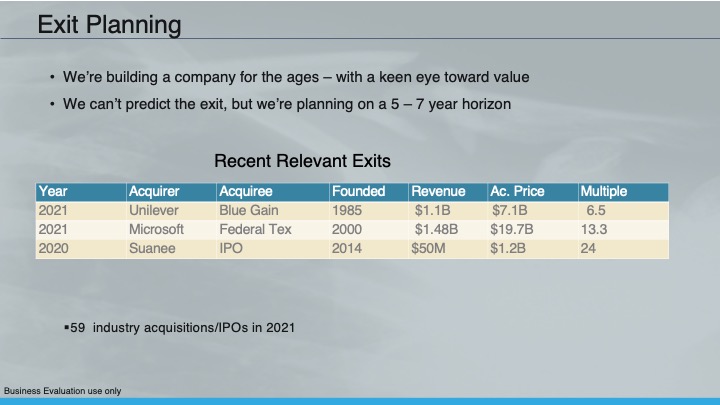The Exit slide focuses on providing liquidity to investors – strategy/how/when/how much. Companies in certain situations must include an Exit slide. Usually the exit discussion is optional, but can be very effective if done properly.
Every business looking to attract investors understands that eventually the company must be acquired or go public (or sometimes end with a revenue-sharing deal) so that investors can get a return on the money they’ve invested. So naturally, potential investors expect the entrepreneur to tell them how they are planning and preparing for that eventuality.
Except not really.
Building a successful business is the best exit strategy and the job of the entrepreneur is to build a thriving, profitable business. If the company can do this, there will be an abundance of great exit opportunities. Most investors understand this, and know that it’s a fool’s quest to predict just when and how the exit will happen
It’s okay to skip the Exit slide altogether. However, what often works well is to have an Exit slide that says, in essence, the exit plan is to build a great business. To that, the entrepreneur can add that they understand that investors have a fixed time horizon for a liquidity event to happen, and the company intends to provide liquidity in that timeframe. Additionally, it’s helpful to display any available data showing the acquisition price paid for comparable companies to the company you’re trying to build, and/or IPO valuations. This can give investors a general feeling for the multiples being paid for companies in your industry, and how robust the acquisition and IPO activity in your industry is
The upshot is that investors get a warm and fuzzy feeling that the company understands the needs of the investor, in addition to some insight on the state of the market.

There are situations where a more fleshed-out Exit slide is almost mandatory. This is when the company is planning to be acquired before commercializing the business, or at some other specific milestone. This is often in the medical/pharma field, where the goal of the company is to prove their solution safe and effective and get regulatory approval to bring the product to market. In that case, the company plans to be acquired at that regulatory milestone, and the timing of the milestone is predicted.
If you’re that entrepreneur, you’ll be asking investors to believe that another firm will assume the marketing and sales challenge and risks at that milestone. Therefore, you have to present an exit strategy that includes the names of potential acquirers, the comparables as discussed above, and any specific plan or progress that you’ve made — such as, that one of your strategic partners has expressed interest in acquisition, etc.
There are non-medical examples as well, such as a company working on a proprietary technology that, if it works, has dramatic upside value but will take more resources to bring to market than the company can afford. Again, the bottom line is that once the company passes a certain milestone, it will look to be acquired.
The other consideration is presentation time. The entrepreneur usually has limited time and much to convey in their investor pitch, and is constantly struggling with what slides should be omitted to fit the time constraint. That is another reason to be brutal in cutting out less important slides – and the Exit slide is usually a good candidate to cut.
Bottom line – if you have a “milestone” business as described above, you need a well thought through Exit slide and presentation. Otherwise, the Exit slide is optional. But perhaps the best option is to have an Exit slide to show that your exit strategy is to build a successful business, understanding that investors expect liquidity in a reasonable timeframe and show comparables — but only if there is time enough in your presentation to convey those thoughts.



0 Comments